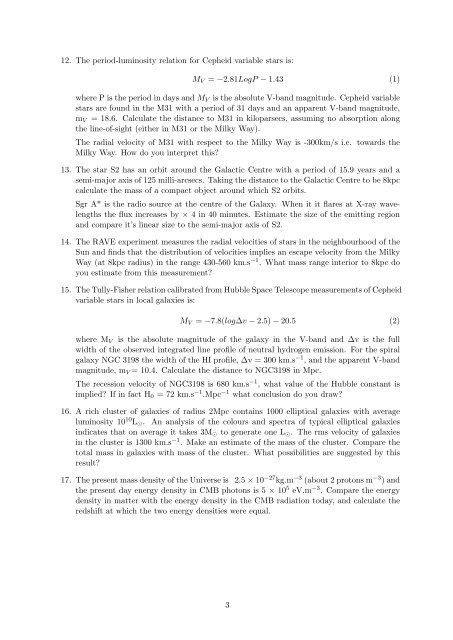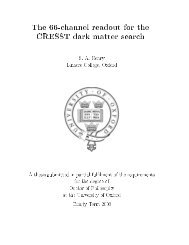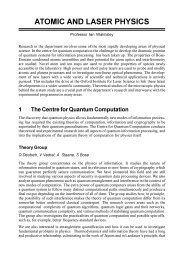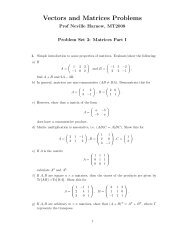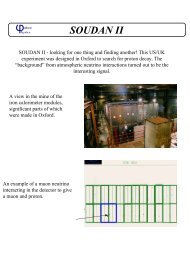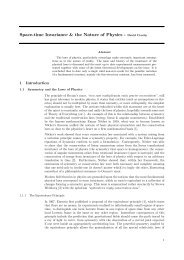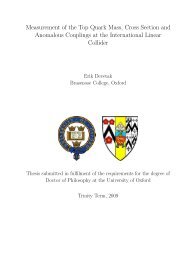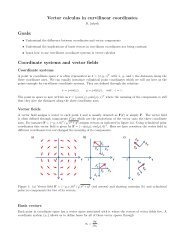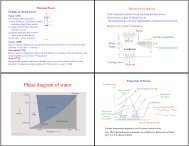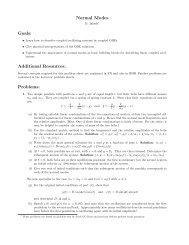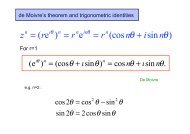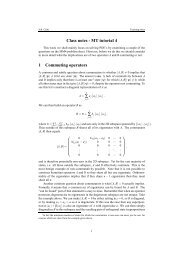S2: Astrophysics: From Planets to The Cosmos Trinity term 2012
S2: Astrophysics: From Planets to The Cosmos Trinity term 2012
S2: Astrophysics: From Planets to The Cosmos Trinity term 2012
You also want an ePaper? Increase the reach of your titles
YUMPU automatically turns print PDFs into web optimized ePapers that Google loves.
12. <strong>The</strong> period-luminosity relation for Cepheid variable stars is:<br />
M V = −2.81LogP − 1.43 (1)<br />
where P is the period in days and M V is the absolute V-band magnitude. Cepheid variable<br />
stars are found in the M31 with a period of 31 days and an apparent V-band magnitude,<br />
m V = 18.6. Calculate the distance <strong>to</strong> M31 in kiloparsecs, assuming no absorption along<br />
the line-of-sight (either in M31 or the Milky Way).<br />
<strong>The</strong> radial velocity of M31 with respect <strong>to</strong> the Milky Way is -300km/s i.e. <strong>to</strong>wards the<br />
Milky Way. How do you interpret this?<br />
13. <strong>The</strong> star <strong>S2</strong> has an orbit around the Galactic Centre with a period of 15.9 years and a<br />
semi-major axis of 125 milli-arcsecs. Taking the distance <strong>to</strong> the Galactic Centre <strong>to</strong> be 8kpc<br />
calculate the mass of a compact object around which <strong>S2</strong> orbits.<br />
Sgr A* is the radio source at the centre of the Galaxy. When it it flares at X-ray wavelengths<br />
the flux increases by × 4 in 40 minutes. Estimate the size of the emitting region<br />
and compare it’s linear size <strong>to</strong> the semi-major axis of <strong>S2</strong>.<br />
14. <strong>The</strong> RAVE experiment measures the radial velocities of stars in the neighbourhood of the<br />
Sun and finds that the distribution of velocities implies an escape velocity from the Milky<br />
Way (at 8kpc radius) in the range 430-560 km.s −1 . What mass range interior <strong>to</strong> 8kpc do<br />
you estimate from this measurement?<br />
15. <strong>The</strong> Tully-Fisher relation calibrated from Hubble Space Telescope measurements of Cepheid<br />
variable stars in local galaxies is:<br />
M V = −7.8(log∆v − 2.5) − 20.5 (2)<br />
where M V is the absolute magnitude of the galaxy in the V-band and ∆v is the full<br />
width of the observed integrated line profile of neutral hydrogen emission. For the spiral<br />
galaxy NGC 3198 the width of the HI profile, ∆v = 300 km.s −1 , and the apparent V-band<br />
magnitude, m V = 10.4. Calculate the distance <strong>to</strong> NGC3198 in Mpc.<br />
<strong>The</strong> recession velocity of NGC3198 is 680 km.s −1 , what value of the Hubble constant is<br />
implied? If in fact H 0 = 72 km.s −1 .Mpc −1 what conclusion do you draw?<br />
16. A rich cluster of galaxies of radius 2Mpc contains 1000 elliptical galaxies with average<br />
luminosity 10 10 L ⊙ . An analysis of the colours and spectra of typical elliptical galaxies<br />
indicates that on average it takes 3M ⊙ <strong>to</strong> generate one L ⊙ . <strong>The</strong> rms velocity of galaxies<br />
in the cluster is 1300 km.s −1 . Make an estimate of the mass of the cluster. Compare the<br />
<strong>to</strong>tal mass in galaxies with mass of the cluster. What possibilities are suggested by this<br />
result?<br />
17. <strong>The</strong> present mass density of the Universe is 2.5 × 10 −27 kg.m −3 (about 2 pro<strong>to</strong>ns m −3 ) and<br />
the present day energy density in CMB pho<strong>to</strong>ns is 5 × 10 5 eV.m −3 . Compare the energy<br />
density in matter with the energy density in the CMB radiation <strong>to</strong>day, and calculate the<br />
redshift at which the two energy densities were equal.<br />
3


